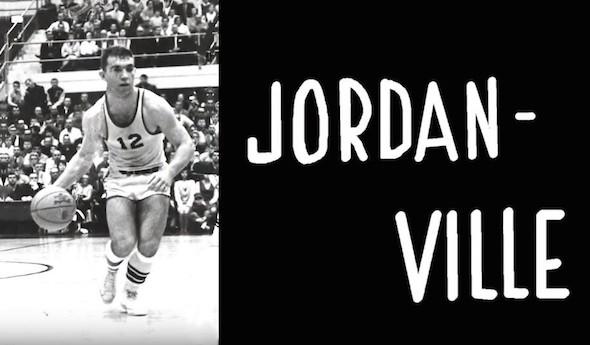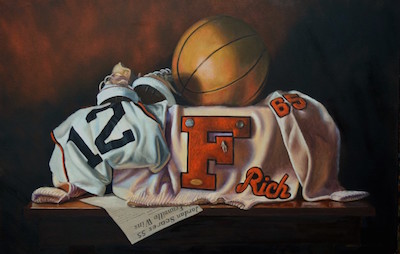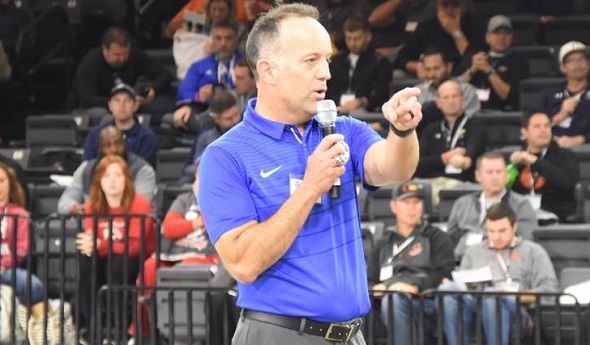
Film Fills In Picture of 'Fennville Flash'
By
Ron Pesch
MHSAA historian
December 28, 2017
We’ve been here before, but not in this way.
The last time was for a retrospective, covering one of the most impressive and awe-inspiring prep careers in Michigan high school history. That time was in print, and included a handful of still images that tried to illustrate the unbelievable.
But this time, the story is in documentary form. It’s woven together from grainy, scratched, faded silent film, a format of capturing memories familiar to thousands of people from generations past, as well as a series of modern-day high-resolution interviews.
Here, the basketball life of the athlete known as the “Fennville Flash” delivers on many levels. Yes, there is a Richie Jordan.
JordanVille, a documentary by John Mooy & Anne Colton, recalls a time when legend spread via word of mouth, newsprint and AM radio.
While it’s hard to comprehend for many today, the exploits of our athletic heroes were formed by “poets in the press box” who sat with pencil and paper, a typewriter, a microphone or a telephone, and described to their audience what they witnessed. On the receiving end, readers and listeners conjured up visualizations based on the facts, phrases and superlatives designed to create an image.
“Traveling left to right on your radio dial” helped listeners feel they were a member of the crowd, seated in the stands, in on the action and a witness to the mayhem. “Packed to the rafters,” reminded fans the importance of what was happening. An exciting game, presented by those with skill, created an event you longed to see. If a broadcast couldn’t be picked up on a transistor or tube radio, the final result might not be known, at the earliest, until the following day’s newspaper arrived.
I’ve told Jordan’s story via the MHSAA before; how he latched on to athletic training, weights and repetition to mold himself into a well-rounded athlete, able to leap to heights unexpected for a kid with a 5-foot-7 frame. The tales of his unfathomable accomplishments slowly leaked beyond the city limits of Fennville into Kalamazoo and greater Southwestern Michigan, then to Detroit. When Detroit Free Press writer Hal Schram relayed Jordan’s feats, the secret traveled across the state and beyond its drawn borders.
From there the legend of Jordan’s accomplishments grew. In Fennville, as in many small towns across the country, the city shut down when a game was played. The Jordan story was so enticing that thousands would travel vast distances to see him play with their own eyes. Today, his single season scoring average of 44.4 points per game during the 1964-65 campaign still remains the top mark in the MHSAA record book.
 JordanVille runs just shy of a half hour. Contained within is insight into the athlete that is challenging to relay in print form. Thanks to access to home movies and a series of interviews with Jordan, former teammates, past opponents and his high school coach, the determination, dedication and drive of a kid who wouldn’t let physical size be a deterrent from achievement radiates from the screen. On display is small town America at its finest, and perspective formed over 50+ years.
JordanVille runs just shy of a half hour. Contained within is insight into the athlete that is challenging to relay in print form. Thanks to access to home movies and a series of interviews with Jordan, former teammates, past opponents and his high school coach, the determination, dedication and drive of a kid who wouldn’t let physical size be a deterrent from achievement radiates from the screen. On display is small town America at its finest, and perspective formed over 50+ years.
For Mooy, it completes a filmmaking journey started six years ago. But the story of Jordan, in his eyes, date back to his school days. Mooy first heard about Jordan as a 7th-grader from a math teacher. A second-team all-St. Joseph Valley League selection, Mooy played at Marcellus High School and scrimmaged against Jordan and the Fennville Blackhawks.
He couldn’t believe his eyes.
“Everyone wanted to see this kid play,” said Mooy in 2011. “He was the first high school player I saw sign an autograph.
Today, with the interviews complete, and the film ready for viewing, Mooy sees more than just a sports story:
“With the benefit of years now passed, I look at the Rich Jordan story with a new respect. JordanVille created a place that was welcoming no matter who you were, or what color your skin happened to be. It was the 1960s. Rich was growing up Jewish, the Civil Rights Movement was in full swing, and the Vietnam War was on everyone's mind. And in Fennville, Michigan, from 1961 to 1965, the Jordan high school years, there were lessons beyond sports being learned by everyone that would last a lifetime. The Jordan household, under the guidance of (his parents) Tuffy and Sylvia Jordan, is where the story begins."
The film speaks of a time that has departed. Competition for our attention was less focused; phones hung on walls or sat on tabletops, communities were tighter, the training table featured peanut butter and chocolate milk instead of protein powder. A city could easily be renamed for a day.
The film also reminds us that those days were far from perfect.
If all goes as planned, the public will see the finished product come the flip of the calendar. In West Michigan, JordanVille is scheduled to show on New Year’s Day at 6 p.m. on WGVU, and will repeat on WGVU-Life at 7:30 p.m., Friday, Jan. 5.
Seek it out, and spread the word, just like in days of old.
 Ron Pesch has taken an active role in researching the history of MHSAA events since 1985 and began writing for MHSAA Finals programs in 1986, adding additional features and "flashbacks" in 1992. He inherited the title of MHSAA historian from the late Dick Kishpaugh following the 1993-94 school year, and resides in Muskegon. Contact him at [email protected] with ideas for historical articles.
Ron Pesch has taken an active role in researching the history of MHSAA events since 1985 and began writing for MHSAA Finals programs in 1986, adding additional features and "flashbacks" in 1992. He inherited the title of MHSAA historian from the late Dick Kishpaugh following the 1993-94 school year, and resides in Muskegon. Contact him at [email protected] with ideas for historical articles.
PHOTOS: (Top) Richie Jordan runs Fennville's offense during his thrilling high school career in the 1960s. (Middle) Jordan memorabilia, as captured by Bill Williams.

Young to Lead BCAM's Next Generation
By
Tom Markowski
Special for Second Half
November 30, 2018
PLYMOUTH – The Basketball Coaches Association of Michigan recently celebrated its 42nd year – and starting Jan. 1, BCAM will welcome just its fourth executive director.
 Tom Hursey, 74, will step down as executive director and hand the gavel over to Dan Young, Hursey’s assistant since 2010.
Tom Hursey, 74, will step down as executive director and hand the gavel over to Dan Young, Hursey’s assistant since 2010.
Young, 50, has been on the BCAM Board of Directors since 1999 and a BCAM member since 1994. He was a boys varsity head coach for 15 years spread over three schools and most recently coached the girls program at Salem (2016-18). He also coaches the boys and girls golf teams at Plymouth.
BCAM got its start in the early 1970s when Hursey, then the boys varsity head coach at Midland High; Ron Vondette, then the boys varsity coach at Carrollton; and other coaches in the Midland-Saginaw area formed the Mid-Michigan Basketball Coaches Association. Hursey and Vondette quickly learned that coaches throughout the state were interested in forming an association, and in 1976 the Michigan High School Basketball Coaches Association was formed. Seven years later, the name changed to what it is known as today – BCAM.
The goal of BCAM and its members is simple – to improve and help the sport grow at all levels.
But the challenges Young faces are quite different from those Hursey confronted when he became executive director in 1997. College recruiting has intensified over the past 20 years, and student-athletes transferring from one high school to another also has become more of a concern for BCAM and the Michigan High School Athletic Association.
In addition, Young said there are other topics his association is currently addressing.
“The buzz right now is seeding,” Young said. “And there’s a committee looking at adding two more games to the season, over the holidays (teams are currently limited to 20 regular season games). Tom and I will meet with (a representative from) the MHSAA to discuss the June camps.”
Though just in its preliminary stages, BCAM, in cooperation with the MHSAA, is seriously considering sponsoring a one-day camp for the top players in the state regardless of class. This is in response to the recommendations made last April by a commission led by Condoleezza Rice, the former U.S. Secretary of State, to aid college coaches in the recruitment of student-athletes. Simply put, the NCAA is attempting to limit how much influence AAU basketball has on the recruitment of high school students, and thereby allow high school coaches to have more influence over their players.
These camps, like the MHSAA/BCAM-sponsored Reaching Higher, allow a large number of players, often more than 100, to receive coaching from high school coaches with college coaches in the gym to evaluate. These also feature speakers who address topics such as entrance tests and what it takes to succeed at the next level, academically and athletically.
Young said the next version could be a two-day event, but he does have some concerns.
“We don’t want to disrupt team camps,” he said. “We’d like to run it with the culture of a team camp. It’s still in its early stages, but I think we’d like to get the top 100 or so players, those that are Division I type of players, and have coaches like (Michigan State coach) Tom Izzo, (Michigan coach) John Beilein, Greg Kampe from Oakland and others be there. Maybe it’ll lasts eight hours. Maybe six. We’d have guest speakers, too.
“It’s possible we’d only invite 60 or 70. We’d take the seniors being recruited by Division I schools, as well as the juniors and sophomores.”
 The camp discussion is an example of why the transition is sure to be a smooth one. Hursey and Young are of one mind on the vast majority of issues BCAM faces. Though a generation apart, they see eye-to-eye on matters of importance. They discuss which battles should be fought and those they should avoid.
The camp discussion is an example of why the transition is sure to be a smooth one. Hursey and Young are of one mind on the vast majority of issues BCAM faces. Though a generation apart, they see eye-to-eye on matters of importance. They discuss which battles should be fought and those they should avoid.
In many ways the transition is similar to that which took place within the MHSAA recently with Mark Uyl taking over for Jack Roberts as executive director. Uyl, 25 years Roberts’ junior, has stated that Roberts has left a legacy, and that he hopes to follow up on that legacy.
“Now that Mark Uyl has taken over, like Dan, a new generation has taken over,” Hursey said.
Hursey and Young are hoping seeding will be introduced within the boys and girls tournaments in the next year or two.
On the subject of transfers, Hursey and Young support the new rule instituted by the MHSAA, which states, in part, that a student who transfers will be ineligible for one full school year at the new school in any sports she or he participated in the previous year at the former school (but eligible immediately in all other sports).
Another concern with regard to transfers is the increasing numbers of top-level players leaving the state and enrolling at prep schools, like Findley Prep in Nevada and others. The most recent top player is Mark “Rocket” Watts who left Old Redford Academy in Detroit and is now enrolled at Spire Academy in Ohio. Watts was considered one of the top candidates for the Mr. Basketball Award, sponsored by BCAM.
Beyond educating players and coaches, and possibly parents, Hursey and Young say there’s little they can do from preventing parents from taking their child out of state.
“It’s a sign of the times,” Hursey said. “Dan and I met with Izzo and we talked for two hours about this. Izzo opened our eyes about it. Take the Old Redford (student). They offer him a beautiful dorm to live in, three square meals and the chance to travel around the country. How are we supposed to compete with that? Izzo said they’re playing 30-to-40 games but that only 10 or so are against the best teams. Those are the ones you see on TV.
“There are a lot of positives for staying with your high school. There’s a lot to be said about high school sports being played at a certain level. And there’s nothing like a Friday night basketball game played in front of 2,000 fans and the place rocking. We just have to keep with what we’re doing. We have to educate the coaches. Some of these fly-by-night operations don’t concentrate on the academic part of school. Yeah, we might lose some of our best players, but there are a lot of good players in this state and there still is great basketball being played. This is not just happening in Michigan. We met with the National (High School) Basketball Coaches Association. It’s a problem throughout the country. How can we compete with millionaires?”
Young said BCAM will continue to do what it does best, and that’s to serve coaches throughout the state and promote and help to improve the game through its many clinics and camps. The website, www.bcam.org, has been improved and updated recently, and provides members and nonmembers alike valuable information.
 Tom Markowski is a correspondent for the State Champs! Sports Network and previously directed its web coverage. He also covered primarily high school sports for the The Detroit News from 1984-2014, focusing on the Detroit area and contributing to statewide coverage of football and basketball. Contact him at [email protected] with story ideas for Oakland, Macomb and Wayne counties.
Tom Markowski is a correspondent for the State Champs! Sports Network and previously directed its web coverage. He also covered primarily high school sports for the The Detroit News from 1984-2014, focusing on the Detroit area and contributing to statewide coverage of football and basketball. Contact him at [email protected] with story ideas for Oakland, Macomb and Wayne counties.
PHOTOS: (Top) Incoming BCAM executive director Dan Young speaks during an event. (Middle) Young and longtime BCAM executive director Tom Hursey, far right, with University of Michigan men’s basketball coach John Beilein. (Photos courtesy of Dan Young.)

